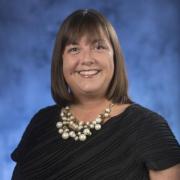From Our President. Change: We Can Make It Happen

You are here
I recently went to the Museum of Fine Arts in Boston to meet a friend for lunch and to see an exhibit. It was a Sunday afternoon, and there was a long line to buy tickets for admission. But there was a much shorter line to become a member. After reading through the list of benefits—which include free admission—and doing some quick math, I realized that membership for one year was equal to the cost of three admission tickets—so I changed lines.
When it was my turn at the membership counter, John, the cashier, asked me several questions. One was, “Are you a K–12 educator?” I answered no, then added, “You know, John, we should really include pre-K educators in that question. In fact, we should include all educators who work with children starting at birth.” With a smile, I asked, “Who can I talk to about that?” John smiled back and said he was not quite sure. I told him I would figure it out!
As I walked away, I was already thinking about a plan for action—whom I could contact, what my key messages would be, what research I would cite, what solutions I would offer, and what my “ask” would be. I am always encouraging other people to advocate, and now I needed to follow my own advice—I was the one who had to take action.
One of the biggest challenges of advocacy is actually following through. I have found that it is easy to get people fired up about the idea of writing a letter to the editor, requesting a meeting with the commissioner of early education and care, calling their elected officials, or testifying at legislative hearings. However, it is much harder to actually do it! There are many reasons why: finding time, having other priorities, not knowing where to start, and hoping someone else will do it, to name a few.
One of the biggest challenges of advocacy is actually following through.
I wondered what it was about this particular situation that sparked my interest. There have been plenty of times and many scenarios in which I have heard education framed as K–12—state governance, increased funding levels for education (while early education funds were cut), other discounts and benefits for educators—when I did not feel compelled to take action. In those cases, I may have fallen into one of my own advocacy traps, feeling I did not have the time or energy to take on the challenge, thinking how hard the situation would be to change, or (again) hoping someone else would tackle the issue. What was different now? Thinking back to an event I had attended in the spring, I was able to connect a few dots and answer that question.
The status quo quandary
In March, the Council of Chief State School Officers and the National Governors Association hosted the Early Care and Education Workforce 2.0 Cross-State Convening. It was an opportunity for teams from 10 states to hear from experts in the field on issues related to the early education and care workforce. At the meeting, I shared the lessons learned from Massachusetts. Attendees also heard from Alison Lutton and Albert Wat.
Alison, former director of NAEYC’s higher education accreditation system and now a consultant supporting early childhood education leaders, opened her presentation with a slide titled “A New Urgency to Resolve Old Questions.” The old questions included defining our profession, our competencies, our credentials, and our pathways. She then reviewed some history and added some context about profession building, posed new questions about the early childhood field, and shared lessons learned. Alison’s discussion was framed around the idea of the power of the status quo.
There is momentum for recognizing the importance of early childhood education.
The power of the status quo—I appreciate that concept, and I believe it captures part of what may be holding us back in much of our work. Change is hard. But there is momentum now across the country for recognizing the importance of and increasing investments in early childhood education. We need to seize this opportunity.
Overcoming the status quo
In his presentation, Albert Wat, senior policy director at the Alliance for Early Success, highlighted a concept called the “Overton window” that resonated with me because it shows us how to overcome the power of the status quo.
The Overton window, named after the free-market advocate Joseph Overton, refers to the range of political ideas people are willing to accept in a given society. The window shifts as that society changes and people become more or less willing to consider different ideas (compare opinion polls about gay marriage from 1995 and 2015 to see what I mean). If advocates want to create social change, they have to fight to move the Overton window and bring their ideas into the mainstream.
Overton died in a plane crash in 2003, before he could see his ideas fully realized; but his friend and colleague Joseph Lehman continued the work. As Derek Robinson writes in Politico, Lehman “formalized and named [the Overton window] in a presentation meant to educate fellow think tank warriors on the power of consistent advocacy. Ring the bell loudly for your idea, no matter how unpopular, and back it up with plenty of research and evidence.”
In other words, the Overton window refers to the concept that a big, bold idea—one that may seem unthinkable and radical when introduced—can eventually become popular and ultimately become policy. In early childhood education terms, such an idea might be doubling the Community Development Block Grant in the federal budget, defining and compensating the early care and education field as a profession, creating universal prekindergarten, or having educators who work with our youngest learners get a membership discount at Boston’s Museum of Fine Arts—and in fact, get benefits everywhere that K–12 educators are offered them! We are early childhood educator warriors, and we need to ring the bell!
Well, it took me two weeks to finally get started on my new advocacy project with the museum. As this column goes to press, I have made some progress but have not finished. I need your help in holding myself accountable! If you see me, ask me how my museum project is going. I am following one of the mantras from Power to the Profession, and I hope you will do the same: “It is time for change. Help make it happen.”
The Politico article “How an Obscure, Conservative Theory Became the Trump Era’s Go-to Nerd Phrase: The ‘Overton Window’ Has Become a Useful, and Misunderstood, Shorthand for the State of American Politics,” by Derek Robertson, is available at https://politi.co/30o0Ue8.
Amy O'Leary serves as President of the NAEYC Governing Board.
